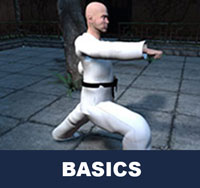Taekwondo 태권도Taekwondo Preschool
Promotion from one geup to the next can proceed rapidly in some schools, since schools often allow geup promotions every two, three, or four months. Students of geup rank learn the most basic techniques first, and then move on to more advanced techniques as they approach first dan. Many of the older and more traditional schools often take longer to allow students to test for higher ranks than newer, more contemporary schools, as they may not have the required testing intervals. View Taekwondo belt levels »

Black Belt Degree
( 단 dan )
When you reach senior belt you are expected to guide the junior belts when they are beginning Taekwondo such as showing by example.
Korean martial arts lacked a grading system up until the Japanese occupation (1910–1945) during which a variety of Japanese martial arts were introduced into the Korean school system, most notably judo, karate - do and kendo. After the occupation ended, newly emerging martial arts like taekwondo, tang soo do, soo bahk do and hapkido adopted the dan (단, 段) and geup (급, 級) ranks. The dan rank system is also used by baduk players. Nowadays, the Korea Taekkyon Association also issues dan ranks to taekkyeon practitioners.
In some Korean schools, most notably in Kukkiwon taekwondo, there is also a poom system in place. Practitioners who have not yet reached the age of 15 cannot test for a dan rank. For them, there is a system of four poom grades. After they reach the age of 15, their poom-grade can be changed to the corresponding "dan"-grade.
For most Korean martial arts, the dan ranks do not go past ninth dan, although on some occasions in some organizations, a tenth dan (십단) has been issued.
Promotion from one dan to the next can take years. The general rule is that a black belt may advance from one rank to the next only after the number of years equivalent to the current rank. For example, a newly promoted third-degree black belt may not be allowed to advance to fourth-degree until three years have passed. Some organizations also have age requirements related to dan promotions, and may grant younger students poom 품 (junior black belt) ranks rather than dan ranks until they reach a certain age.
Black belt ranks may have titles associated with them, such as "master" and "instructor" but taekwondo organizations vary widely in rules and standards when it comes to ranks and titles. What holds true in one organization may not hold true in another, as is the case in many martial art systems. For example, achieving first dan ranking with three years' training might be typical in one organization, but fast in another organization, and likewise for other ranks. Similarly, the title for a given dan rank in one organization might not be the same as the title for that dan rank in another organization.
In the International Taekwondo Federation (ITF), instructors holding 1st to 3rd dan are called Boosabum (assistant instructor), those holding 4th to 6th dan are called Sabum (instructor), those holding 7th to 8th dan are called Sahyun (master), and those holding 9th dan are called Saseong (grandmaster). This system does not, however, necessarily apply to other taekwondo organizations.
In the World Taekwondo (WT), students holding 1st-3rd dan are considered an Instructor, but generally have much to learn. Students who hold a 4th - 6th dan are considered Masters and must be at least 18 years old. Masters who hold a 7th - 9th dan are considered a Grandmaster. This rank also holds an age requirement of 40+.

World Taekwondo (WT) Black Belt Forms
Each Dan (degree of black belt) also has its own associated pattern that is required for black belt testing. The forms have a higher degree of difficulty in Taekwondo techniques. View more information about World Taekwondo (WT) Black Belt section ».

International Taekwondo Federation (ITF) Black Belt Forms
Each dan (degree of black belt) also has its own associated form/pattern that is required for black belt testing. The forms have a higher degree of difficulty in Taekwondo techniques. View more information about International Taekwondo Federation (ITF) Main Forms section »
- Kwang Gae (39 Movements) 1st dan
- Po-Eun (36 Movements) 1st dan
- Ge-Baek (44 Movements) 1st dan
- Eui-Am (45 Movements) 2nd dan
- Choong-Jang (52 Movements) 2nd dan
- Juche (45 Movements)/Ko-Dang (39 Movements) 2nd dan
- Sam-Il (33 Movements) 3rd dan
- Yoo-Sin (68 Movements) 3rd dan
- Choi-Yong (46 Movements) 3rd dan
- Yon-Gae (49 Movements) 4th dan
- Ul-Ji (42 Movements) 4th dan
- Moon-Moo (61 Movements) 4th dan
- So-San (72 Movements) 5th dan
- Se-Jong (24 Movements) 5th dan
- Tong-Il (56 Movements) 6th dan

Taekwondo Basics
Here is where you can learn more about Taekwondo 태권도. Knowing the fundamental basics is very important for your learning path as you build your skills and knowledge. There are certain rules that need to be followed to show respect to the master ( 사범님 sabeomnim ), the instructors ( 교사님 gyosannim ), other practitioners and to the martial arts. They vary between schools but many have similar rules and guidelines. For more information View Taekwondo Basics »
Promotion from one dan to the next can take years. The general rule is that a black belt may advance from one rank to the next only after the number of years equivalent to the current rank. For example, a newly promoted third-degree black belt may not be allowed to advance to fourth-degree until three years have passed.
RESOURCES
This article uses material from the Wikipedia articles "Dan (rank)" and "Taekwondo", which is released under the Creative Commons Attribution-Share-Alike License 3.0.






























